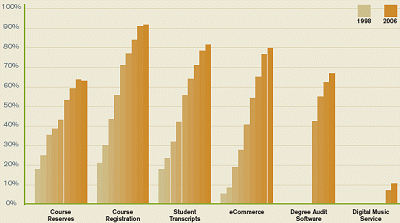Following the Web 2.0 Piper
Where retail and consumer websites lead, will higher ed follow?

Trends in Website Services: Services on the campus website, percentage of
reporting institutions by category, 1998 to 2006
Source: Campus Computing Survey, 2006.
CAMPUS COMPUTING’S annual survey reveals a tidy growth trend among higher
education website services reported from 1998 to
2006, and the gains over the years have been substantial:
Nearly four-fifths (79.9 percent) of institutions participating
in the 2006 survey reported that they can process credit
card payments from the campus website, compared to a
mere 5.1 percent capable of online transactions reported
in 1998. More than nine-tenths (91.5 percent) now offer
online course registration, up from just one-fifth in the
1998 survey. And the “new kid on the block,” digital music
service, has at least established a foothold.
While these data may suggest a remarkably productive
environment, the 2006 report points out that the services
on higher ed sites still don’t compare favorably to those on
polished commercial sites. The consumer market—sporting
sites from Amazon.com, the airlines, banks, and others—
provides highly customized support and services that
simply aren’t yet available in higher education web offerings.
Campus Computing founding director Kenneth
Green tells Campus Technology, “The consumer experience
defines and raises students’ expectations for campuses’
online resources and services. Today, students
come to campus or to online courses to learn about, and
also learn with, technology.”
Still, the technologies that power Amazon.com and numerous
other online-shopping and consumer-service sites are
not rocket science. What would it take for higher education
to catch up? What’s the missing piece? Green explains that
it’s more than just technology. “Colleges and universities are
only beginning to recover from the 2001 to 2004 budget
cuts in IT and elsewhere. The ‘Web 2.0’ technologies that
power consumer sites and corporate operations involve
investment and planning.” This is not something that campuses
simply “decide,” says Green. “These technologies
must be integrated into an existing infrastructure, which
means that the key campus ERP providers—Datatel, Jenzabar, Oracle, and SunGard Higher Education, among others—need to integrate
these front-end services into their ERP offerings for their campus clients,” he explains.